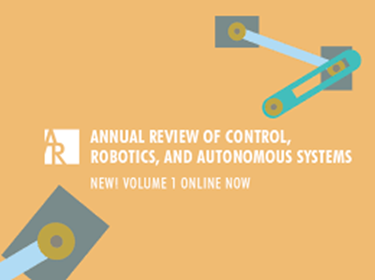在微型机器人中利用液体表面张力
IF 14
1区 计算机科学
Q1 AUTOMATION & CONTROL SYSTEMS
Annual Review of Control Robotics and Autonomous Systems
Pub Date : 2022-11-30
DOI:10.1146/annurev-control-062422-102559
引用次数: 2
摘要
已知表面张力效应在亚毫米尺度上占主导地位。在此背景下,文献广泛地描述了潜在的物理(例如,表面张力,润湿,表面纹理和涂层),并且毛细力已经在各种应用中被利用(例如,毛细拾取,自校准,毛细密封和毛细轴承)。由于多种刺激可用于控制液体半月板,这些力主要用于开环的微型机器人(即没有实时反馈)。然而,至少有两个主要的不确定性来源阻碍了这些力在开环中正常工作:由于接触角滞后引起的可变性(湿润和非湿润之间的差异)以及所涉及的液体体积的可变性。为了能够拒绝这些干扰,需要在毛细管微型机器人微系统中嵌入成功的传感器集成和相关的先进控制方案。本文从表面张力效应的刺激作用(光、b场等)、应用领域(驱动、采摘、封口等)以及传感和控制方案三个不同角度分析了该领域的研究贡献。技术上复杂的开发与优雅、直接的工程解决方案并存。本综述不包括表面张力的生物学方面。预计《控制、机器人和自主系统年度评论》第14卷的最终在线出版日期是2023年5月。修订后的估计数请参阅http://www.annualreviews.org/page/journal/pubdates。本文章由计算机程序翻译,如有差异,请以英文原文为准。
Exploiting Liquid Surface Tension in Microrobotics
Surface tension effects are known to be dominant at the submillimeter scale. Within this context, the literature has extensively described the underlying physics (e.g., surface tension, wetting, surface texturation, and coatings), and capillary forces have been exploited in a variety of applications (e.g., capillary picking, self-alignment, capillary sealing, and capillary bearings). As several stimuli can be used to control liquid menisci, these forces have been used mainly in microrobotics in open loop (i.e., without real-time feedback). However, at least two major sources of uncertainty hinder these forces from working properly in open loop: the variability due to contact-angle hysteresis (the difference between wetting and unwetting) and the variability in the involved volume of liquid. To be able to reject these disturbances, successful sensor integration and associated advanced control schemes need to be embedded in capillary microrobotic microsystems. This article analyzes research contributions in this field from three different perspectives: the stimulus action of the surface tension effect (light, B-field, etc.), the application field (actuation, picking, sealing, etc.), and the sensing and control schemes. Technologically complex developments coexist with elegant and straightforward engineering solutions. Biological aspects of surface tension are not included in this review. Expected final online publication date for the Annual Review of Control, Robotics, and Autonomous Systems, Volume 14 is May 2023. Please see http://www.annualreviews.org/page/journal/pubdates for revised estimates.
求助全文
通过发布文献求助,成功后即可免费获取论文全文。
去求助
来源期刊
CiteScore
28.30
自引率
2.20%
发文量
25
期刊介绍:
The Annual Review of Control, Robotics, and Autonomous Systems offers comprehensive reviews on theoretical and applied developments influencing autonomous and semiautonomous systems engineering. Major areas covered include control, robotics, mechanics, optimization, communication, information theory, machine learning, computing, and signal processing. The journal extends its reach beyond engineering to intersect with fields like biology, neuroscience, and human behavioral sciences. The current volume has transitioned to open access through the Subscribe to Open program, with all articles published under a CC BY license.

 求助内容:
求助内容: 应助结果提醒方式:
应助结果提醒方式:


